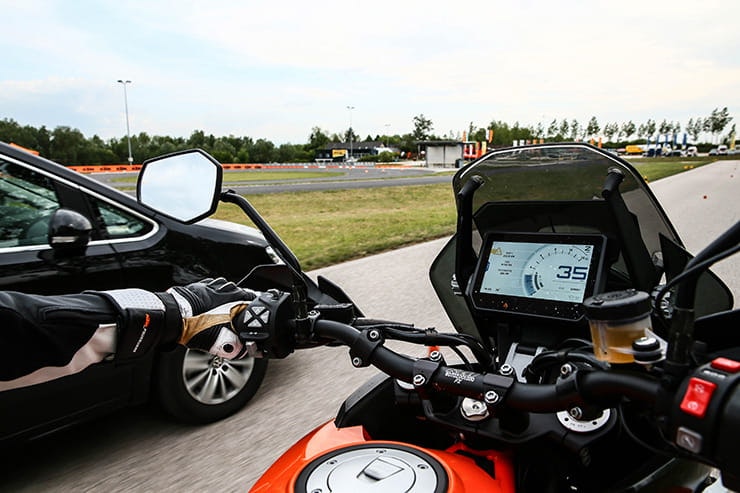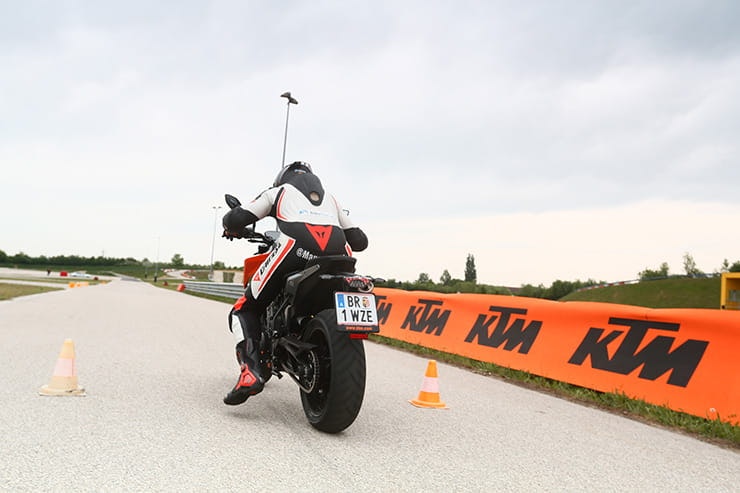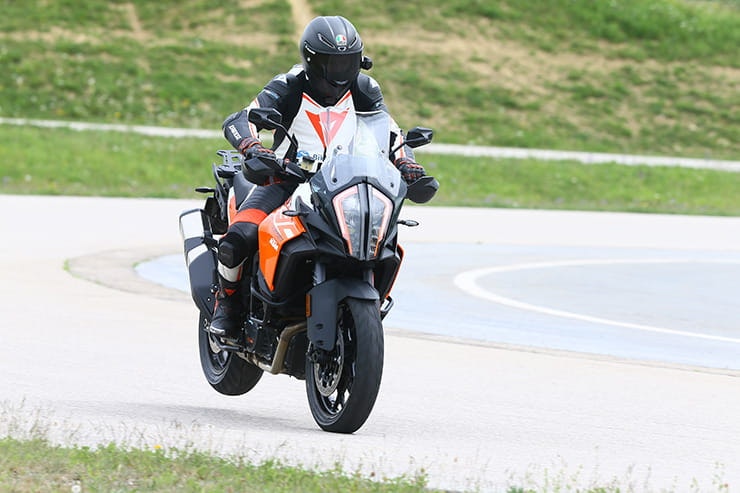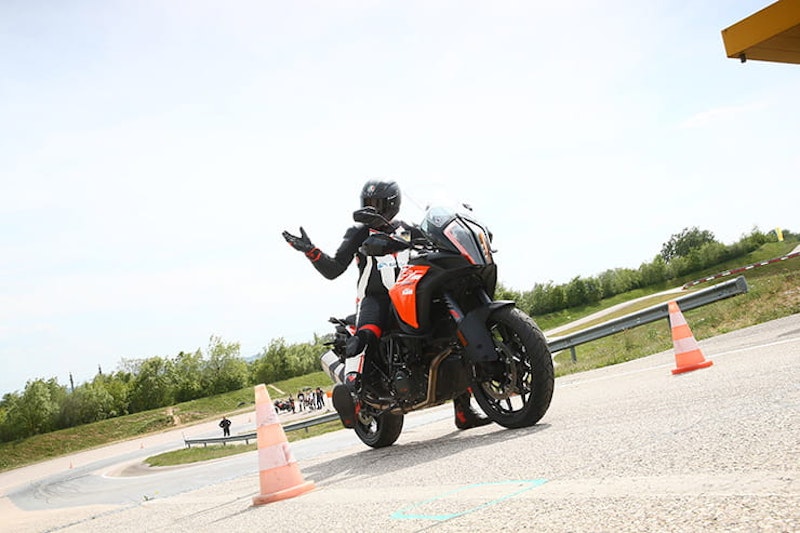Testing KTM's range of electronics at their secret facility (inc. video)
By Michael Mann
BikeSocial Managing Editor
31.08.2018
Do you know your SCU’s from your ACC’s?* Even if you did, do you know how they work? A question like that could easily belong to a Mastermind specialist subject round and if you don’t work in the R&D department at KTM then it may prove tricky.
So, it was a good job the Austrian firm invited BikeSocial to its secret test facility in the company’s homeland to talk through and demonstrate just how some of the world’s most technologically advanced motorcycles work. They even allowed us to test them on the big 160bhp 1290 Super Adventure S & R models plus the delightfully rambunctious 790 Duke, all in a controlled environment.
And during one experiment when the instructor encourages me to pull on the front brake as hard as possible while committed to a decent lean angle (ok, not elbow down GP-style lean but more than your average roundabout-circulating angle) I learned quickly to trust what he says and therefore what the bike promises to do. It’s hard after all the years of telling yourself not to do such a thing to then overrule it.
“It’s not about reinventing physics, it’s changing the natural reactions of riding” said Gerald Matschl, KTM’s Vice President of R&D.
We’ve all been privy to new technology helping cars, vans and lorries become safer for the driver, passengers and even nearby pedestrians and other road users, with the relevant aids filtering through to motorbikes eventually, making riding safer while protecting the rider too. Although not every rider wants 21st century functionality and performance; most still consider the heart of motorcycling to be the internal combustion engine and for some it’s a machine that doesn’t have an automatic choke let alone rider modes, electronically adjustable suspension, hill-hold functionality and hazard perception warnings.
KTM’s invitation allowed us to discover both modern day and even futuristic methods of increasing safety without compromising that all-important enjoyment element because motorcycling isn’t just functional, it’s a hobby with benefits.
After all, pretty much every manufacturer has developed their own acronyms to describe their technological advancements to make riding safer and to protect the rider too.
Magic. Hill hold control in action.
From hill-hold control to launch control and testing what it’s like to grab the front brake when leant over in a corner all in a safe environment as well as laying down 160hp when off-road, these are just some of the examples of KTM’s rigorous testing situations prior to their machines getting anywhere near a dealership. Thousands of miles, hundreds of variables and hours of feedback from the fleet of expert testers and R&D employees give KTM the data required to make their bikes as advanced as possible, all while looking further ahead to the other technologies that will assist.
From the introduction of ABS on the 990 Adventure in 2006 the last 12 years have seen a raft of new tech making their way in the KTM range from ride-by-wire and off-road ABS to MSR (Motor Slip Regulation) to anti-wheelie. As sensor technology has evolved, so has cornering safety, bike stability and comfort which is all well and good when you consider 160bhp is now being squeezed out of an adventure bike.
These features have been designed so they don’t detract from the riding experience and instead enhance performance. Here’s an overview of how KTM’s technology has evolved across its range:
History of KTM Technology
1996 - 620 Duke: first with electric start
2005 - 990 Superduke fuel injection
2006 - ABS on 990 adventure
2012 – Ride-by-wire on 690 Duke
2013 - 1190 Adventure with MTC, rider modes, tyre pressure, electronic damping, DRL (low beam always aims down and for approx. 40m)
2013 - Off-road ABS (690 Enduro R) and Supermoto ABS (690 SMC R and 690 Duke R)
2014 - 125 Duke is the first 125 fitted with 2-channel ABS as standard.
2014 - ABS with cornering function via MSC on 1190 Adventure / R
2015 - 1290 Super Adventure has HHC - hill hold, MSR - motor slip regulation (reverse TC - synchronised wheel speed when heavy braking with a little throttle adds to the stability), ATIR - automatic turn indicator reset (either 150m or 10s), cruise control, cornering lights, semi active suspension
2016 - Quickshifter on 1290 Super Duke GT and TFT display on 690 Duke/R
2017 - 1290 Super Duke R with quickshifter+, RACE ON (wireless key), launch control, anti-wheelie off plus 1290 Super Adventure S/R with LED Headlight with integrated cornering and KTM MY RIDE
2018 – 1290 Super Adventure S/R with KTM MY RIDE navigation
The bike is braking because the car is slowing but the rider is not touching the front or rear brake.
Two pieces of tech we couldn’t test but were still demonstrated by Mr. Matschl on a specially-adapted 1290 Super Adventure R are still in development and are due on KTM bikes “not for next year” but soon:
ACC - Adaptive Cruise Control – a sensor in the front of the bike detects vehicles and automatically brakes or accelerates if the ‘locked on’ vehicle does the same.
Blind Spot Detection - LED lights in mirrors and dashboard to warn if something is approaching from behind.
As Matschl set the cruise control to follow the van in front, he lifted his right leg up and away from the rear brake at the same time as removing his right hand from the bar and away from the front brake yet when the van slowed so did the bike. Yes, we’ve seen this type of wizardry in cars for a while but this is the first time it’s been seen and talked about in bikes. Effective? Yes. An unnecessary complication to an already cluttered array of buttons and acronyms? Maybe. But the jury is out and if it saves just one life then of course it will be worth every penny and hour spent on its development.
We asked Luke Brackenbury – PR Manager, KTM (Street bikes) – to run through the day’s workshops including semi-active suspension modes, hill hold control, launch control and off-road ABS:
Behind-the-scenes: KTM test their technology
At KTM’s Austrian testing facilities we get to try the full technology suite available on the 1290 Super Adventure and 790 DUKE | BikeSocial
VIDEO TRANSCRIPT
What is KTM’s philosophy behind all this advancement in technology?
It’s features that help riders control the bikes without losing the joy of riding. KTM is a rider’s company, we build the bikes we want to ride, we want to have fun riding them. So, if we’re going to add these sort of electronic rider aids they can’t detract from the riding fun, they’ve got to add to it somehow. We’re the sort of company that comes up with supermoto abs and things like that so that’s our philosophy – it’s got to add to it. We’re a dynamic company, ‘ready-to-race’ this whole attitude, so that’s how we approach the safety systems.
Cornering ABS – it’s fascinating but how does it work?
It’s an ABS system that allows you to remain committed to your corner trajectory. Obviously, it’s built within us that if we’re in that panic situation that we brake, we stand the bike up and sometimes we’re in that situation that when we stand the bike we’re faced with an obstacle that isn’t good. So, the cornering abs system that can be found on a range of our bikes now, allows you to maintain that trajectory. You can pull the brakes on as hard as you want which goes against your instinct but the system can do it. On the 1290 Super Adventure’s, it’s modulating it knows how leant over you are, it knows how much pressure to give you, and you can then stand the bike up so it can give you more and it’s modulating between the front and rear brake. Then on the 790 DUKE, it’s just working with the front system. It knows how far over you are leant over and it’s giving you as much pressure as the tyre can handle and to maintain that trajectory then you can stand it up if you need to. It’s an amazing system that once you can trust it, even a couple of guys have had to use it for real on the road. They didn’t plan to use it but it’s an incredible system that puts motorcycling safety to the next level. You know that should a situation like that happen that you can pull on the brakes as hard as you dare and you know the bike will look after you.
We say: I’m aware of the amount of low-siding taking place in BSB, MotoGP and the like which plays in the back of my mind as I set off at the recommended 60kph (37mph) on the large diameter roundabout, running anticlockwise. To begin with I’m on the 1290 Super Adventure and it takes a few attempts to get brave and pull harder on the front brake lever trusting that the bike and its sensors will do as it should. It’s a mind-bending exercise – going against natural instincts and having faith that tech will save you. If there’s an animal, car, pedestrian on the next bend then I know the KTM will give me a much better chance, even if it is a natural reaction to grab the front brake.
3, 2, 1, Go.
Launch control on the 790
Launch control was a system that we brought in last year on the 2.0 version of the 1290 Super Duke R, especially on a bike like that with so much horsepower and performance, it’s a way of getting off the line in a quick way. You hold the throttle open and the bike is set at peak torque so you feed the power out with the clutch, you don’t need to modulate the throttle so the bike is keeping the front end down for a clean getaway. We were able to bring that suit of electronics to the 790 DUKE, the system can do three launches in a row.
We say: only available once a bike has completed its first service (1000km / 620 miles), it’s a hoot but not massively beneficial. Fighting natural instincts once again, to release the clutch (modulating not just dumping) while the throttle held completely open is a test. You tell yourself that anti-wheelie is on and also to get into second gear using the quickshifter as quickly as possible because once your away and feet are on the pegs the rpm red line has almost been met. Turns out I was 5kph faster through the speed trap without launch control!
A bit of dive in the sportier setting and loads of mechanical grip
Suspension settings on the 1290 was interesting
Semi-active is what we have on the 1290 Super Duke GT and the 1290 Super Adventure S, it’s reacting to the roads. We put this on the bikes that people will tour on; our travel enduros and our sports tourer. It gives you options at the push of the button, if you have a partner on the back with the luggage or you’re on a long road that isn’t the most fun to ride but you want to be comfortable then you’ve got that. Then when the road opens up and it’s twisty then at the push of a button you can set the damping and you can ride a bit harder with it on sport. The bike pitches more with the anti-dive allowing for more heat into the tyres and therefore more grip and as we explained with the two different mentalities with this approach; more sport you want the wheels in contact with the ground at all times and the rider maybe moves around but when it’s comfortable you want the rider staying still and the pillion not banging around and then you’re sacrificing a little bit of grip. So, it’s about showing how quick you can adjust that so you don’t need to stop and whip out the spanners. The electronic pre-loads and the dynamic of the bike can be set for your luggage and your passenger very quickly and very easily.
We say: “leave the spanners at home and rely on the touch of a button” is music to my non-mechanically oriented ears. While preload has to be adjusted while stationary, damping can be adjusted on the fly, takes just a few seconds and doesn’t even require shutting the throttle or dipping the clutch.
Demonstrating all levels of traction control
Onto the off-road section for both traction control and ABS demonstrations
It was a pretty extreme demonstration. We have bikes like the 1290 Super Adventure R with a lot of performance which is very capable and there are riders who buy the bike who perhaps aren’t that confident off-road riders but they know with these systems they can get the power down. 160hp with no traction control is spinning and digging a hole and not going anywhere but put the off-road mode on and while it still spins so you can slide and drift but it’s finding grip as well so you can go forwards. And the off-road ABS, this demonstration was to show how it differs from the street system. On that lose gravel you saw me braking as hard as I could, you braked as hard as you could and it digs in and finds the grip by slipping a little and comes to a complete stop but you can still block the rear and skid, so this is a demonstration to show how these systems work in extreme ways.
We say: with 160bhp on offer the bike is going to be a right handful but the off-road specific traction setting allows the rear to slip a little but in a more controllable manner making you feel like an off-road god…momentarily. Whip the throttle back and let the electronics do their job while you concentrate on styling it up! On the brakes and the clever ABS system doesn’t just dig and slip but allows a degree of roll before coming to a controlled halt, though as demonstrated on the video I anticipated the stop a little too soon.
And then onto the Hill Hold Control
When you come to a stop on an incline you do that thing where you put it in gear and put the back brake on and get ready to set off and dance around. With Hill Hold Control when you come to a stop, the bike detects you’re on a slope and applies the rear brake for just over 3 seconds meaning that you can become quite settled. As we demonstrated you can take your hand off the brake lever and it hold you there, when you pull away it slowly disengages the rear. If you’re staying there longer on the slope the you can reapply it with the brake.
I’m sure plenty of bikes get dropped from silly situations like that and with the lean angle sensitivity and the gyroscopes we’re able to add that function. Is it safety? Yes I suppose people drop bikes and damage them which is really annoying. I dropped a bike last year in a stupid, silly way and it’s to help prevent that sort of thing so perhaps riders can be more comfortable when it comes to coming to a stop with luggage and a passenger.
It’s a bit like the Automatic Turn Indicator Reset System (ATIRS); it cuts the indicators off. Does that save lives? Probably. You know what it’s like sometimes you leave the indicators on and maybe a car thinks you’re going to turn into a junction and pulls out. It’s about coming up with systems that, be it quite simple, can make a difference.
So we went onto that hill with some really, really slippery tarmac that I’ve been telling you not to ride on all day. Then we went to ride on it to show the ride modes and the different levels of traction control. So, the first time we did it on the 1290 Super Adventure S we had it with no traction control. 160hp was like riding on ice, it was just spinning and you’re barely going up the hill. And then we tried Rain mode and Sport and Street and you could see how traction control was finding grip on that really slippery surface without juddering and cutting in. Even when you left the slippery surface onto the grippy stuff, it didn’t jolt. Again, it was quite an extreme demonstration to show how the traction control intervenes in those different modes with different power and different delivery.
We say: The slippery uphill surface was ideal to demonstrate the traction control settings as well as hill hold control. Stick the bike in rain mode and with full throttle the rear wheel barely slips ¼ of a turn and edges you up the hill slowly but with full stability. Hill hold control is a simple but firm squeeze of the front brake which is good for three seconds. It can then be reapplied. For such a tall bike, the 1290 SuperAdventure becomes more controllable at an uphill T-junction, for example, even for a 6-footer like me.
*The answers are: Suspension Control Unit and Adaptive Cruise Control
Share on social media:



